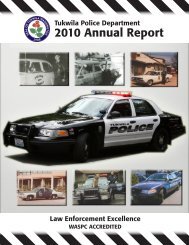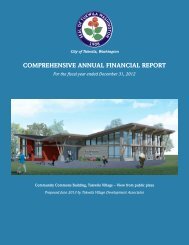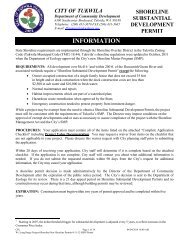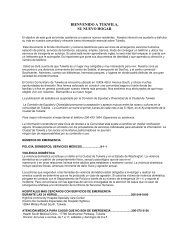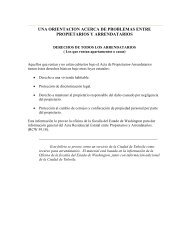2013-2014 Biennial Budget <strong>City</strong> <strong>of</strong> <strong>Tukwila</strong>, WashingtonEXPENDITURES – ALL FUNDSThe total expenditure and transfers out budgeted is $125.4 million for 2013 and $127.6 million for 2014.This is an overall growth in 2013 <strong>of</strong> 14.6% over <strong>the</strong> 2012 budgeted expenditures. The 2014 expenditureprojection is 1.7% over <strong>the</strong> 2013 projected amount. Significant increase in 2013 is mainly due to a onetime increase in <strong>the</strong> transfer <strong>of</strong> resources between funds. Transfers between funds are shown in <strong>the</strong> nondepartmental,Dept. 20 line in <strong>the</strong> chart below. It is anticipated that $8.5 million will be transferred into<strong>the</strong> General Fund from Bridges & Arterial Street Fund from <strong>the</strong> LID reimbursement and $4.4 million into<strong>the</strong> General Fund from <strong>the</strong> Facilities Fund for proceeds on <strong>the</strong> <strong>Tukwila</strong> Village land sale. Excluding nondepartmental,Dept. 20 expenditures, <strong>the</strong> increase from 2012 to 2013 is only 4.3%.The budget continues to fund all existing positions and places an emphasis on public safety andcomprehensive crime reduction by adding five positions in support <strong>of</strong> crime reduction initiatives.Additional staffing increases include increasing <strong>the</strong> CERT trainer in Fire from half-time to full-time andan additional maintenance worker in Public Works Street Maintenance. Salary increases include stepincreases and COLA increases.The <strong>City</strong> is self-insured for health costs. Premiums have not increased for active employees. Currentpremium rates for active employees will maintain an adequate incurred but not reported (IBNR) reservebased on an actuarial evaluation. Funding for LEOFF 1 retirees has been reduced for <strong>the</strong> biennial periodbased on actuarial projections and current overfunding for this program. O<strong>the</strong>r benefits, includingretirement and L & I, have been increased as necessary.Funding has also been added to continue <strong>the</strong> Strategic Planning process which will enable <strong>the</strong> <strong>City</strong> toensure future success in aligning priorities with resources. The funds will provide for <strong>the</strong> next stage <strong>of</strong>implementation <strong>of</strong> <strong>the</strong> Strategic Plan.Departments continue to find operating efficiencies in an effort to lower costs for supplies and services.Operations and maintenance costs are funded for same level <strong>of</strong> services except where noted inindividual department budgets. General cost increases include inflationary increases, utility rateincreases, and increases in contracts for services.Capital items were funded based on submission <strong>of</strong> formal requests. The budget also includes funding toinvolve <strong>the</strong> community and Council for scoping activity for <strong>City</strong> buildings that would house police,firefighters, and o<strong>the</strong>r <strong>City</strong> employees. Additionally, <strong>the</strong> budget creates an annual investment in safesidewalks in neighborhoods. In addition to <strong>the</strong> 2013-2014 biennial budget, an additional $2 million hasbeen added to <strong>the</strong> <strong>City</strong>’s six-year plan that will provide safe pathways and connectivity where needed.Budget changes in each department have been grouped into <strong>the</strong> following categories with narrativesexplaining major changes:• Non-Discretionary: Costs over which departments have little or no control over such as changesin salaries and benefits, utilities, and interlocal agreements.• Discretionary: Departments have <strong>the</strong> ability to move funds among budget lines at <strong>the</strong>irdiscretion such as reducing supplies and increasing outside maintenance costs.• Initiatives: Budget increases in this category are for priorities identified through <strong>the</strong> strategicplanning process and include funding for <strong>the</strong> Neighborhood Resource Center, equipment for <strong>the</strong>Police bike patrol, enforcement <strong>of</strong> <strong>the</strong> nuisance ordinance, code enforcement, technology, andcommunity outreach.Page 57
2013-2014 Biennial Budget <strong>City</strong> <strong>of</strong> <strong>Tukwila</strong>, Washington• Revenue Backed: Expenditures that are funded by grants, costs associated with annexations, andfees paid by outside agencies for services.• Transfers: Program costs that have been moved from one department or fund to ano<strong>the</strong>r. Forexample, insurance and claims and judgment costs were transferred from Department 20 to <strong>the</strong>Finance department.Expenditure Summary – All FundsEXPENDITURE2010 2010-2011 2011 2011-2012 2012 2012-2013 2013 2013-2014 2014Actual % Change Actual % Change Budget % Change Budget % Change BudgetSalaries $ 27,240,505 0.17% $ 27,287,955 6.69% $ 29,113,295 2.64% $ 29,882,836 3.07% $ 30,800,150Benefits 14,405,445 -6.86% 13,417,700 14.26% 15,331,678 -5.53% 14,484,486 5.12% 15,226,094Total Salaries and Benefits 41,645,949 -2.26% 40,705,655 9.19% 44,444,973 -0.17% 44,367,322 3.74% 46,026,244Total Supplies 7,144,293 7.74% 7,697,143 5.98% 8,157,800 3.03% 8,405,205 0.58% 8,454,277Pr<strong>of</strong>essional Services 6,880,311 2.58% 7,057,527 38.14% 9,749,164 15.00% 11,211,372 -26.64% 8,225,173Communication 381,065 -16.97% 316,392 36.25% 431,081 6.19% 457,746 0.13% 458,346Travel 54,204 49.82% 81,211 85.28% 150,465 -1.10% 148,815 -6.38% 139,315Advertising 579,901 11.71% 647,825 10.31% 714,600 10.93% 792,700 -1.89% 777,700Operating Rentals & Leases 1,750,004 36.90% 2,395,668 10.19% 2,639,716 4.16% 2,749,586 -0.78% 2,728,265Insurance 517,659 1.42% 525,004 19.33% 626,510 8.90% 682,250 1.76% 694,250Public Utility Services 1,420,820 9.33% 1,553,425 9.90% 1,707,200 0.65% 1,718,317 1.32% 1,741,040Repairs & Maintenance 744,024 53.58% 1,142,643 -25.64% 849,706 14.11% 969,636 16.84% 1,132,908Miscellaneous 1,249,369 0.02% 1,249,557 -15.82% 1,051,919 74.38% 1,834,352 0.89% 1,850,752Total O<strong>the</strong>r Services and Charges 13,577,356 10.25% 14,969,251 19.71% 17,920,361 14.76% 20,564,774 -13.70% 17,747,749Total Intergovernmental Services 4,052,371 20.51% 4,883,478 16.53% 5,690,475 -29.47% 4,013,518 3.96% 4,172,522Total Capital Outlays 10,188,748 162.41% 26,736,369 -30.63% 18,548,000 -0.35% 18,483,906 67.25% 30,915,181Total Debt Service 5,089,378 82.91% 9,309,038 -47.57% 4,881,191 66.03% 8,104,483 -36.40% 5,154,085EXPENDITURE TOTAL 81,698,095 27.67% 104,300,934 -4.47% 99,642,800 4.31% 103,939,208 8.21% 112,470,058Non-Departmental, Dept 20 3,110,829 281.73% 11,875,080 -17.58% 9,787,540 119.27% 21,461,375 -29.59% 15,111,928TOTAL EXPENDITURES &TRANSFERS $ 84,808,923 36.99% $ 116,176,015 -5.81% $ 109,430,340 14.59% $ 125,400,582 1.74% $ 127,581,9862013 – 2014 Expenditure Budget by TypeTransfers - OutDebt ServiceCapital OutlaysIntergovernmentalO<strong>the</strong>r Services and ChargesSupplies20142013Salaries and Benefits$- $5 $10 $15 $20 $25 $30 $35 $40 $45 $50MillionsPage 58
- Page 1:
City of Tukwila, Washington2013-201
- Page 4 and 5:
2013-2014 Biennial Budget City of T
- Page 6 and 7:
2013-2014 Biennial Budget City of T
- Page 8 and 9: 2013-2014 Biennial Budget City of T
- Page 10 and 11: 2013-2014 Biennial Budget City of T
- Page 12 and 13: 2013-2014 Biennial Budget City of T
- Page 14 and 15: 2013-2014 Biennial Budget City of T
- Page 16 and 17: 2013-2014 Biennial Budget City of T
- Page 18 and 19: 2013-2014 Biennial Budget City of T
- Page 20 and 21: 2013-2014 Biennial Budget City of T
- Page 22 and 23: 2013-2014 Biennial Budget City of T
- Page 24 and 25: 2013-2014 Biennial Budget City of T
- Page 26 and 27: 2013-2014 Biennial Budget City of T
- Page 28 and 29: 2013-2014 Biennial Budget City of T
- Page 30 and 31: 2013-2014 Biennial Budget City of T
- Page 32 and 33: 2013-2014 Biennial Budget City of T
- Page 34 and 35: 2013-2014 Biennial Budget City of T
- Page 36 and 37: 2013-2014 Biennial Budget City of T
- Page 38 and 39: 2013-2014 Biennial Budget City of T
- Page 40 and 41: 2013-2014 Biennial Budget City of T
- Page 42 and 43: 2013-2014 Biennial Budget City of T
- Page 44 and 45: 2013-2014 Biennial Budget City of T
- Page 46 and 47: 2013-2014 Biennial Budget City of T
- Page 48 and 49: 2013-2014 Biennial Budget City of T
- Page 50 and 51: 2013-2014 Biennial Budget City of T
- Page 52 and 53: 2013-2014 Biennial Budget City of T
- Page 54 and 55: 2013-2014 Biennial Budget City of T
- Page 56 and 57: 2013-2014 Biennial Budget City of T
- Page 60 and 61: 2013-2014 Biennial Budget City of T
- Page 62 and 63: 2013-2014 Biennial Budget City of T
- Page 64 and 65: 2013-2014 Biennial Budget City of T
- Page 66 and 67: 2013-2014 Biennial Budget City of T
- Page 68 and 69: 2013-2014 Biennial Budget City of T
- Page 70 and 71: 2013-2014 Biennial Budget City of T
- Page 72 and 73: 2013-2014 Biennial Budget City of T
- Page 74 and 75: 2013-2014 Biennial Budget City of T
- Page 76 and 77: 2013-2014 Biennial Budget City of T
- Page 78 and 79: 2013-2014 Biennial Budget City of T
- Page 80 and 81: 2013-2014 Biennial Budget City of T
- Page 82 and 83: 2013-2014 Biennial Budget City of T
- Page 84 and 85: 2013-2014 Biennial Budget City of T
- Page 86 and 87: 2013-2014 Biennial Budget City of T
- Page 88 and 89: 2013-2014 Biennial Budget City of T
- Page 90 and 91: 2013-2014 Biennial Budget City of T
- Page 92 and 93: 2013-2014 Biennial Budget City of T
- Page 94 and 95: 2013-2014 Biennial Budget City of T
- Page 96 and 97: 2013-2014 Biennial Budget City of T
- Page 98 and 99: 2013-2014 Biennial Budget City of T
- Page 100 and 101: 2013-2014 Biennial Budget City of T
- Page 102 and 103: 2013-2014 Biennial Budget City of T
- Page 104 and 105: 2013-2014 Biennial Budget City of T
- Page 106 and 107: 2013-2014 Biennial Budget City of T
- Page 108 and 109:
2013-2014 Biennial Budget City of T
- Page 110 and 111:
2013-2014 Biennial Budget City of T
- Page 112 and 113:
2013-2014 Biennial Budget City of T
- Page 114 and 115:
2013-2014 Biennial Budget City of T
- Page 116 and 117:
2013-2014 Biennial Budget City of T
- Page 118 and 119:
2013-2014 Biennial Budget City of T
- Page 120 and 121:
2013-2014 Biennial Budget City of T
- Page 122 and 123:
2013-2014 Biennial Budget City of T
- Page 124 and 125:
2013-2014 Biennial Budget City of T
- Page 126 and 127:
2013-2014 Biennial Budget City of T
- Page 128 and 129:
2013-2014 Biennial Budget City of T
- Page 130 and 131:
2013-2014 Biennial Budget City of T
- Page 132 and 133:
2013-2014 Biennial Budget City of T
- Page 134 and 135:
2013-2014 Biennial Budget City of T
- Page 136 and 137:
2013-2014 Biennial Budget City of T
- Page 138 and 139:
2013-2014 Biennial Budget City of T
- Page 140 and 141:
2013-2014 Biennial Budget City of T
- Page 142 and 143:
2013-2014 Biennial Budget City of T
- Page 144 and 145:
2013-2014 Biennial Budget City of T
- Page 146 and 147:
2013-2014 Biennial Budget City of T
- Page 148 and 149:
2013-2014 Biennial Budget City of T
- Page 150 and 151:
2013-2014 Biennial Budget City of T
- Page 152 and 153:
2013-2014 Biennial Budget City of T
- Page 154 and 155:
2013-2014 Biennial Budget City of T
- Page 156 and 157:
2013-2014 Biennial Budget City of T
- Page 158 and 159:
2013-2014 Biennial Budget City of T
- Page 160 and 161:
2013-2014 Biennial Budget City of T
- Page 162 and 163:
2013-2014 Biennial Budget City of T
- Page 164 and 165:
2013-2014 Biennial Budget City of T
- Page 166 and 167:
2013-2014 Biennial Budget City of T
- Page 168 and 169:
2013-2014 Biennial Budget City of T
- Page 170 and 171:
2013-2014 Biennial Budget City of T
- Page 172 and 173:
2013-2014 Biennial Budget City of T
- Page 174 and 175:
2013-2014 Biennial Budget City of T
- Page 176 and 177:
2013-2014 Biennial Budget City of T
- Page 178 and 179:
2013-2014 Biennial Budget City of T
- Page 180 and 181:
2013-2014 Biennial Budget City of T
- Page 182 and 183:
2013-2014 Biennial Budget City of T
- Page 184 and 185:
2013-2014 Biennial Budget City of T
- Page 186 and 187:
2013-2014 Biennial Budget City of T
- Page 188 and 189:
2013-2014 Biennial Budget City of T
- Page 190 and 191:
2013-2014 Biennial Budget City of T
- Page 192 and 193:
2013-2014 Biennial Budget City of T
- Page 194 and 195:
2013-2014 Biennial Budget City of T
- Page 196 and 197:
2013-2014 Biennial Budget City of T
- Page 198 and 199:
2013-2014 Biennial Budget City of T
- Page 200 and 201:
2013-2014 Biennial Budget City of T
- Page 202 and 203:
2013-2014 Biennial Budget City of T
- Page 204 and 205:
2013-2014 Biennial Budget City of T
- Page 206 and 207:
2013-2014 Biennial Budget City of T
- Page 208 and 209:
2013-2014 Biennial Budget City of T
- Page 210 and 211:
2013-2014 Biennial Budget City of T
- Page 212 and 213:
2013-2014 Biennial Budget City of T
- Page 214 and 215:
2013-2014 Biennial Budget City of T
- Page 216 and 217:
2013-2014 Biennial Budget City of T
- Page 218 and 219:
2013-2014 Biennial Budget City of T
- Page 220 and 221:
2013-2014 Biennial Budget City of T
- Page 222 and 223:
2013-2014 Biennial Budget City of T
- Page 224 and 225:
2013-2014 Biennial Budget City of T
- Page 226 and 227:
2013-2014 Biennial Budget City of T
- Page 228 and 229:
2013-2014 Biennial Budget City of T
- Page 230 and 231:
2013-2014 Biennial Budget City of T
- Page 232 and 233:
2013-2014 Biennial Budget City of T
- Page 234 and 235:
2013-2014 Biennial Budget City of T
- Page 236 and 237:
2013-2014 Biennial Budget City of T
- Page 238 and 239:
2013-2014 Biennial Budget City of T
- Page 240 and 241:
2013-2014 Biennial Budget City of T
- Page 242 and 243:
2013-2014 Biennial Budget City of T
- Page 244 and 245:
2013-2014 Biennial Budget City of T
- Page 246 and 247:
2013-2014 Biennial Budget City of T
- Page 248 and 249:
2013-2014 Biennial Budget City of T
- Page 250 and 251:
2013-2014 Biennial Budget City of T
- Page 252 and 253:
2013-2014 Biennial Budget City of T
- Page 254 and 255:
2013-2014 Biennial Budget City of T
- Page 256 and 257:
2013-2014 Biennial Budget City of T
- Page 258 and 259:
2013-2014 Biennial Budget City of T
- Page 260 and 261:
2013-2014 Biennial Budget City of T
- Page 262 and 263:
2013-2014 Biennial Budget City of T
- Page 264 and 265:
2013-2014 Biennial Budget City of T
- Page 266 and 267:
2013-2014 Biennial Budget City of T
- Page 268 and 269:
2013-2014 Biennial Budget City of T
- Page 270 and 271:
2013-2014 Biennial Budget City of T
- Page 272 and 273:
2013-2014 Biennial Budget City of T
- Page 274 and 275:
2013-2014 Biennial Budget City of T
- Page 276 and 277:
2013-2014 Biennial Budget City of T
- Page 278 and 279:
2013-2014 Biennial Budget City of T
- Page 280 and 281:
2013-2014 Biennial Budget City of T
- Page 282 and 283:
2013-2014 Biennial Budget City of T
- Page 284 and 285:
2013-2014 Biennial Budget City of T
- Page 286 and 287:
2013-2014 Biennial Budget City of T
- Page 288 and 289:
2013-2014 Biennial Budget City of T
- Page 290 and 291:
2013-2014 Biennial Budget City of T
- Page 292 and 293:
2013-2014 Biennial Budget City of T
- Page 294 and 295:
2013-2014 Biennial Budget City of T
- Page 296 and 297:
2013-2014 Biennial Budget City of T
- Page 298 and 299:
2013-2014 Biennial Budget City of T
- Page 300 and 301:
2013-2014 Biennial Budget City of T
- Page 302 and 303:
2013-2014 Biennial Budget City of T
- Page 304 and 305:
2013-2014 Biennial Budget City of T
- Page 306 and 307:
2013-2014 Biennial Budget City of T
- Page 308 and 309:
2013-2014 Biennial Budget City of T
- Page 310 and 311:
2013-2014 Biennial Budget City of T
- Page 312 and 313:
2013-2014 Biennial Budget City of T
- Page 314 and 315:
2013-2014 Biennial Budget City of T
- Page 316 and 317:
2013-2014 Biennial Budget City of T
- Page 318 and 319:
2013-2014 Biennial Budget City of T
- Page 320 and 321:
2013-2014 Biennial Budget City of T
- Page 322 and 323:
2013-2014 Biennial Budget City of T
- Page 324 and 325:
2013-2014 Biennial Budget City of T
- Page 326 and 327:
2013-2014 Biennial Budget City of T
- Page 328 and 329:
2013-2014 Biennial Budget City of T
- Page 330 and 331:
2013-2014 Biennial Budget City of T
- Page 332 and 333:
2013-2014 Biennial Budget City of T
- Page 334 and 335:
2013-2014 Biennial Budget City of T
- Page 336 and 337:
2013-2014 Biennial Budget City of T
- Page 338 and 339:
2013-2014 Biennial Budget City of T
- Page 340 and 341:
2013-2014 Biennial Budget City of T
- Page 342 and 343:
2013-2014 Biennial Budget City of T
- Page 344 and 345:
2013-2014 Biennial Budget City of T
- Page 346 and 347:
2013-2014 Biennial Budget City of T
- Page 348 and 349:
2013-2014 Biennial Budget City of T
- Page 350 and 351:
2013-2014 Biennial Budget City of T
- Page 352 and 353:
2013-2014 Biennial Budget City of T
- Page 354 and 355:
2013-2014 Biennial Budget City of T
- Page 356 and 357:
2013-2014 Biennial Budget City of T
- Page 358 and 359:
City of TukwilaCapital Improvement
- Page 360 and 361:
City of TukwilaCapital Improvement
- Page 362 and 363:
2013-2014 Biennial Budget City of T
- Page 364 and 365:
2013-2014 Biennial Budget City of T
- Page 366 and 367:
2013-2014 Biennial Budget City of T
- Page 368 and 369:
2013-2014 Biennial Budget City of T
- Page 370 and 371:
2013-2014 Biennial Budget City of T
- Page 372 and 373:
2013-2014 Biennial Budget City of T
- Page 374 and 375:
2013-2014 Biennial Budget City of T
- Page 376 and 377:
2013-2014 Biennial Budget City of T
- Page 378 and 379:
2013-2014 Biennial Budget City of T
- Page 380 and 381:
2013-2014 Biennial Budget City of T
- Page 382 and 383:
2013-2014 Biennial Budget City of T




